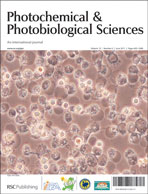The effect of humic acid (HA) aggregate formation on the photosensitized generation and subsequent quenching of singlet molecular oxygen O2(a1Δg) was investigated. Time-resolved O2(a1Δg) phosphorescence traces were obtained from (a) bulk samples of HA dispersions and (b) microscope-based experiments performed upon irradiation of a single HA aggregate. In the bulk experiments, the dependence of the O2(a1Δg) lifetime on the HA concentration yields a critical concentration for the formation of micrometric HA aggregates of 0.58 g L−1. This value is consistent with that obtained using pyrene as a fluorescent probe (0.38 g L−1). Microscope-based experiments were also performed with HA samples containing added singlet oxygen sensitizers; either the hydrophobic meso-tetraphenylporphyrin (TPP) or the hydrophilic 5,10,15,20-tetrakis(N-methyl-4-pyridyl)-21H,23H-porphine (TMPyP). Singlet oxygen phosphorescence could only be detected upon irradiation of TMPyP, a molecule which localizes on the exterior part of the HA aggregates. The inability to detect O2(a1Δg) phosphorescence from HA samples containing TPP is consistent with the model that the O2(a1Δg) produced in the interior of the aggregate was completely quenched by the high local concentration of HA reactive groups in this environment.

You have access to this article
 Please wait while we load your content...
Something went wrong. Try again?
Please wait while we load your content...
Something went wrong. Try again?


 Please wait while we load your content...
Please wait while we load your content...